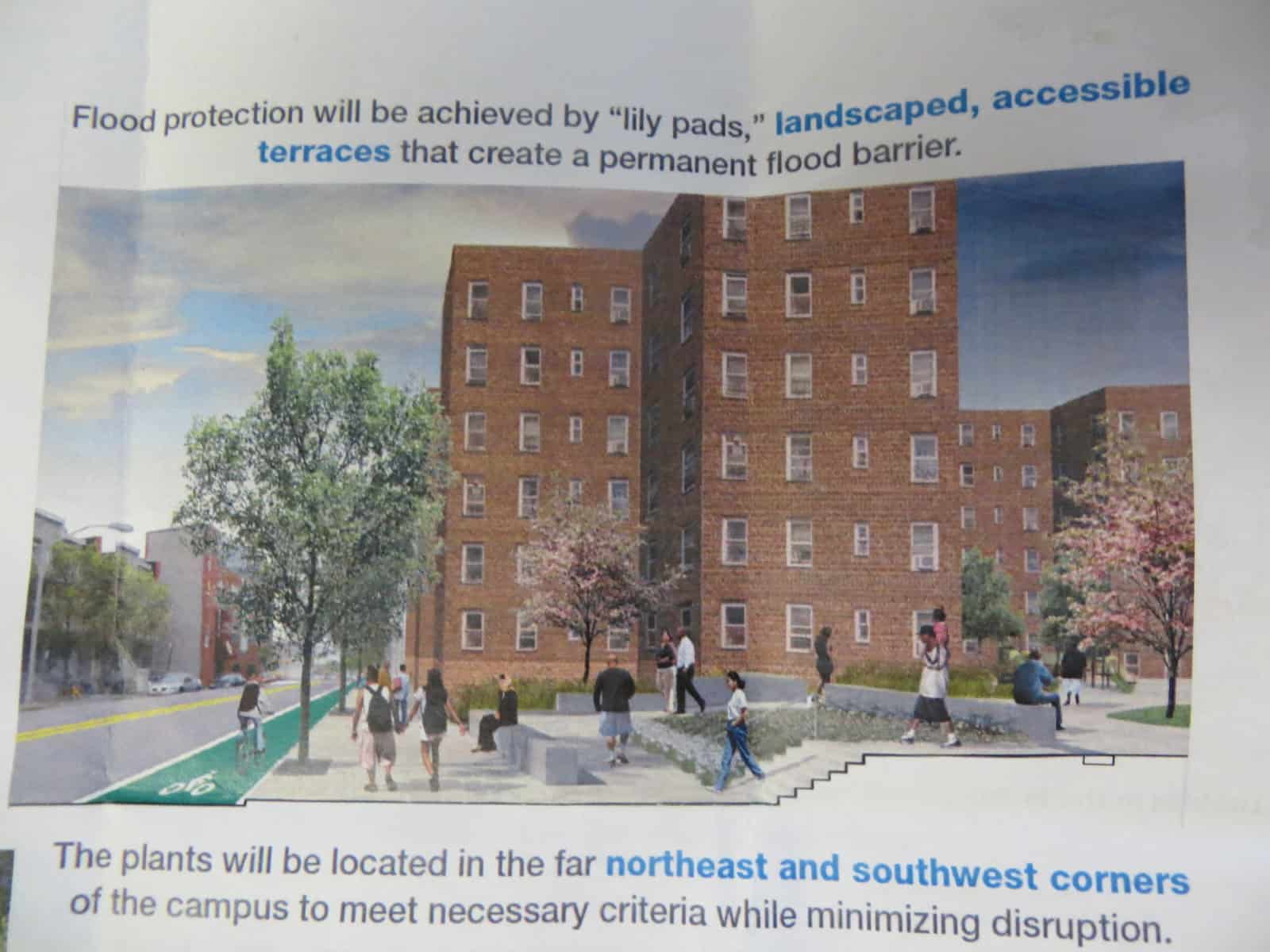In a stunning reversal from the past, NYCHA held a great meeting Monday night at the Miccio Center. The purpose was to present preliminary plans for an upgrade of the Red Hook Houses using money that FEMA has granted for improving the development to better cope with future flood disasters.

A common complaint at many prior meetings NYCHA has held since Sandy is the lack of follow-up. Residents constantly complain about dirty lobbies and elevators, leaking roofs, mold, garbage and the like, and NYCHA representatives listen defensively and promise to get things fixed. In the end, the lack of money is usually blamed for a lack of action.
At Monday’s meeting, this all seemed a thing of the past. Instead of having to listen to NYCHA employees, in the past seemed to have been talking down to residents, the presentation was made by members of the design team who were noticably eager to be part of an improvement of the lives of residents. They actually referred to the development as a “campus,” a term generally used for more upscale groups of buildings, such as colleges or Google’s offices.
Of course, federal funding is what has made this possible. Money from the US government has been steadily falling as a conservative Congress has worked very hard to cut public spending and lower corporate taxes and eliminate government regulations. In this case, however, the Sandy disaster forced them to approve the demands of New York’s legislators. Congresswoman Nydia Velazquez, who opened the meeting, said that her congressional district, which includes Red Hook, Williamsburg and also the Lower East Side of Manhattan, received well over a billion dollars in FEMA funds, of which Red Hook gets over $400 million.
Evidently, NYCHA has done the right thing and hired good people to design the improvements. And they look like real improvements. They showed drawings of their plans, which include suggestions made by the community at a previous meeting. They were evidently really listening, and ticked off a number of design changes they made based upon what people who came to the previous meeting at the Miccio asked for.
The most important improvements involve heating and electricity. The biggest disaster following Sandy was almost three weeks without electricity and heat throughout much of the campus, as the basement boiler rooms were all flooded out. Since Sandy, gasoline powered temporary boilers have been providing heat. These will be replaced by two large 2-story structures serving as central power plants for East and West.[slideshow_deploy id=’3104′]
Not only will they be more efficient and presumably better, but the first floors will be used for additional services, including convenience stores. High tech computer sensors will automatically switch on gas-fired generators within ten seconds of any future blackout caused by a Con Ed failure. These improvements alone bring public housing to the 21st century – finally.
But there is more. Playgrounds will be improved, roofs will be replaced, all walls damaged by floodwaters will be fixed, outside lighting will be made better and more attractive, lobbies and elevators will be renovated, outside walls will made water resistant, and all lobby doors will be changed and made more secure, as will the closed circuit cameras.
Just the above sounds like a fantasy for those used to living in buildings with dirty lobbies and smelly elevators that don’t always run. But there’s more.
“Lily pads” and “pods” were heard throughout the presentations. The lily pads refer to new terraces that will be built around all the buildings. They will raise the level of the grounds, serving as flood barriers. At the same time, they will upgrade the aesthetics, giving public housing residents some of the amenities that residents of luxury condo developments take for granted.
It was gratifying that suggestions made by residents were actually heard and incorporated into these designs. These include a nicer walk to Smith and 9th Street, keeping Centre Mall as open space, friendlier and better lighting, the playground upgrades and no loss of parking.
A big suggestion that was heard at this meeting was for local hiring when the construction actually begins. At the end of the meeting, Michael Rosen, recently appointed NYCHA’s Vice President for Disaster Recovery, and a familiar face at meetings involving the rebuilding of the Senior Center, announced that the next NYCHA meeting at the Miccio will take the form of a job fair.
Of course, Red Hook has been the recipient of many broken promises from NYCHA over the years. Councilman Carlos Menchaca, who closed the meeting, was optimistic but also promised to hold NYCHA’s feet to the fire, to make sure that this time the promises are kept.









One Comment
This is great news for Red Hook Houses- I’d like to raise a concern and point out an opportunity. I’m part of the AIA NY’s “Design for Aging” Committee, and we’ve been looking at making NYCHA housing more age-friendly. I’d love a chance to meet with your designers and review with special consideration of what makes housing work for our seniors. With the monies available now, this is a rare opportunity that I’d hate to miss. Thank you,
gail ressler, gail ressler Interior Design